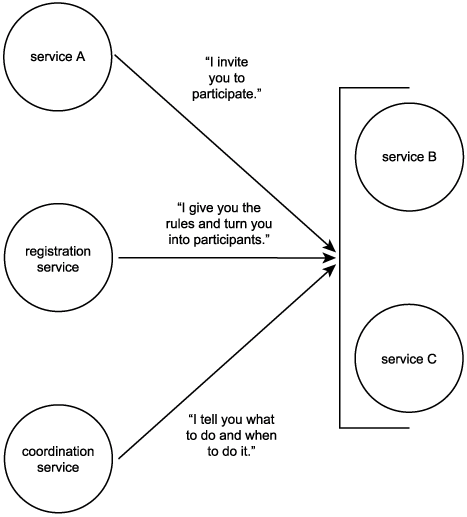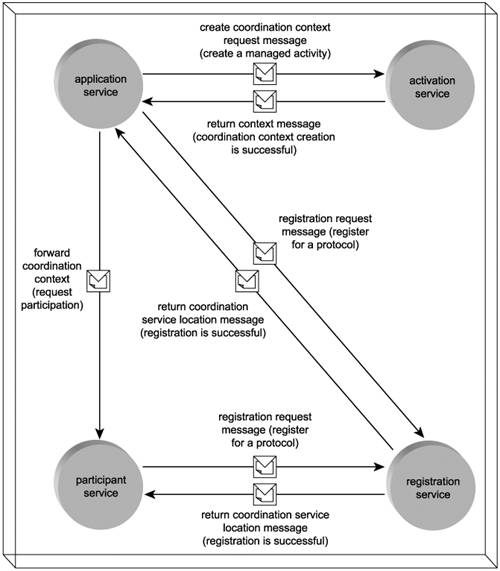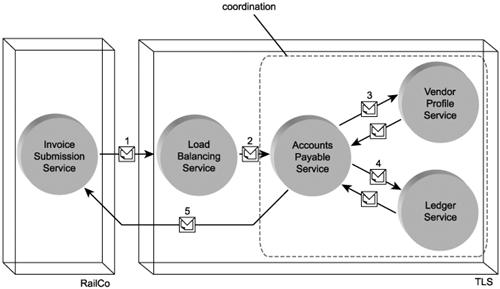Coordination
Every activity introduces a level of context into an application runtime environment. Something that is happening or executing has meaning during its lifetime, and the description of its meaning (and other characteristics that relate to its existence) can be classified as context information.
The more complex an activity, the more context information it tends to bring with it. The complexity of an activity can relate to a number of factors, including:
- the amount of services that participate in the activity
- the duration of the activity
- the frequency with which the nature of the activity changes
- whether or not multiple instances of the activity can concurrently exist
A framework is required to provide a means for context information in complex activities to be managed, preserved and/or updated, and distributed to activity participants. Coordination establishes such a framework (Figure 6.14).
Figure 6.14. Coordination provides services that introduce controlled structure into activities.

Note
This section derives concepts from the WS-Coordination specification. Some examples of WS-Coordination SOAP headers are provided in the WS-Coordination overview section of Chapter 16.
6.3.1. Coordinator composition
WS-Coordination establishes a framework that introduces a generic service based on the coordinator service model (Figure 6.15). This service controls a composition of three other services that each play a specific part in the management of context data.
Figure 6.15. The coordinator service composition.

The coordinator composition consists of the following services:
- Activation service Responsible for the creation of a new context and for associating this context to a particular activity.
- Registration service Allows participating services to use context information received from the activation service to register for a supported context protocol.
- Protocol-specific services These services represent the protocols supported by the coordinator's coordination type. (This is further explained in the next sections.)
- Coordinator The controller service of this composition, also known as the coordination service.
6.3.2. Coordination types and coordination protocols
Each coordinator is based on a coordination type, which specifies the nature and underlying logic of an activity for which context information is being managed. Coordination types are specified in separate specifications. The WS-Coordination framework is extensible and can be utilized by different coordination types, including custom variations. However, the two coordination types most commonly associated with WS-Coordination are WS-AtomicTransaction and WS-BusinessActivity. (Concepts relating to these specifications are explained in the upcoming Atomic transactions and Business activities sections.)
Coordination type extensions provide a set of coordination protocols, which represent unique variations of coordination types and consist of a collection of specific behaviors and rules. A protocol is best viewed as a set of rules that are imposed on activities and which all registered participants must follow.
6.3.3. Coordination contexts and coordination participants
A context created by the activation service is referred to as a coordination context. It contains a collection of information that represents the activity and various supplementary data.
Examples of the type of data held within a coordination context include:
- a unique identifier that represents the activity
- an expiration value
- coordination type information
A service that wants to take part in an activity managed by WS-Coordination must request the coordination context from the activation service. It then can use this context information to register for one or more coordination protocols. A service that has received a context and has completed registration is considered a participant in the coordinated activity.
6.3.5. The activation and registration process
The coordination service composition is instantiated when an application service contacts the activation service (Figure 6.16). Via a CreateCoordinationContext request message, it asks the activation service to generate a set of new context data. Once passed back with the ReturnContext message, the application service now can invite other services to participate in the coordination. This invitation consists of the context information the application service originally received from the activation service.
Figure 6.16. The WS-Coordination registration process.

Any Web service in possession of this context information may issue a registration request to the registration service. This allows the service to enlist in a coordination based on a specific protocol. (Protocols are provided by separate specifications and are discussed later in this chapter as part of the Atomic transaction and Business activities sections.) Upon a successful registration, a service is officially a participant. The registration service passes the service the location of the coordinator service, with which all participants are required to interact. At this time, the coordination service is also sent the address of the new participant.
6.3.5. The completion process
The application service can request that a coordination be completed by issuing a completion request message to the coordination service. The coordinator, in turn, then issues its own completion request messages to all coordination participants. Each participant service responds with a completion acknowledgement message (Figure 6.17).
Figure 6.17. The WS-Coordination completion process.

6.3.6. Coordination and SOA
A coordinator-based context management framework, as provided by WS-Coordination and its supporting coordination types, introduces a layer of composition control to SOAs (Figure 6.18). It standardizes the management and interchange of context information within a variety of key business protocols.
Figure 6.18. Coordination as it relates to other parts of SOA.

Coordination also alleviates the need for services to retain state. Statelessness is a key service-orientation principle applied to services for use within SOAs. Coordination reinforces this quality by assuming responsibility for the management of context information.
Case StudyIn the previous case study example, we established the individual process steps that comprised a complex activity. Once the processing of this activity enters the TLS environment, TLS employs a context management system to coordinate the flow of the message through its internal services. As shown in Figure 6.19, coordination is applied to the following steps:
Figure 6.19. The TLS Accounts Payable, Vendor Profile, and Ledger Services being managed by a coordination. 
The atomic transaction coordination type is used to coordinate these processing steps, as explained in the next two case studies. |
|
SUMMARY OF KEY POINTS |
|---|
|
Introduction
- Why this book is important
- Objectives of this book
- Who this book is for
- What this book does not cover
- How this book is organized
- Additional information
Case Studies
- Case Studies
- How case studies are used
- Case #1 background: RailCo Ltd.
- Case #2 background: Transit Line Systems Inc.
Part I: SOA and Web Services Fundamentals
Introducing SOA
- Introducing SOA
- Fundamental SOA
- Common characteristics of contemporary SOA
- Common misperceptions about SOA
- Common tangible benefits of SOA
- Common pitfalls of adopting SOA
The Evolution of SOA
- The Evolution of SOA
- An SOA timeline (from XML to Web services to SOA)
- The continuing evolution of SOA (standards organizations and contributing vendors)
- The roots of SOA (comparing SOA to past architectures)
Web Services and Primitive SOA
- Web Services and Primitive SOA
- The Web services framework
- Services (as Web services)
- Service descriptions (with WSDL)
- Messaging (with SOAP)
Part II: SOA and WS-* Extensions
Web Services and Contemporary SOA (Part I: Activity Management and Composition)
- Web Services and Contemporary SOA (Part I: Activity Management and Composition)
- Message exchange patterns
- Service activity
- Coordination
- Atomic transactions
- Business activities
- Orchestration
- Choreography
Web Services and Contemporary SOA (Part II: Advanced Messaging, Metadata, and Security)
- Web Services and Contemporary SOA (Part II: Advanced Messaging, Metadata, and Security)
- Addressing
- Reliable messaging
- Correlation
- Policies
- Metadata exchange
- Security
- Notification and eventing
Part III: SOA and Service-Orientation
Principles of Service-Orientation
- Principles of Service-Orientation
- Service-orientation and the enterprise
- Anatomy of a service-oriented architecture
- Common principles of service-orientation
- How service-orientation principles inter-relate
- Service-orientation and object-orientation (Part II)
- Native Web service support for service-orientation principles
Service Layers
- Service Layers
- Service-orientation and contemporary SOA
- Service layer abstraction
- Application service layer
- Business service layer
- Orchestration service layer
- Agnostic services
- Service layer configuration scenarios
Part IV: Building SOA (Planning and Analysis)
SOA Delivery Strategies
- SOA Delivery Strategies
- SOA delivery lifecycle phases
- The top-down strategy
- The bottom-up strategy
- The agile strategy
Service-Oriented Analysis (Part I: Introduction)
- Service-Oriented Analysis (Part I: Introduction)
- Service-oriented architecture vs. Service-oriented environment
- Introduction to service-oriented analysis
- Benefits of a business-centric SOA
- Deriving business services
Service-Oriented Analysis (Part II: Service Modeling)
- Service-Oriented Analysis (Part II: Service Modeling)
- Service modeling (a step-by-step process)
- Service modeling guidelines
- Classifying service model logic
- Contrasting service modeling approaches (an example)
Part V: Building SOA (Technology and Design)
Service-Oriented Design (Part I: Introduction)
- Service-Oriented Design (Part I: Introduction)
- Introduction to service-oriented design
- WSDL-related XML Schema language basics
- WSDL language basics
- SOAP language basics
- Service interface design tools
Service-Oriented Design (Part II: SOA Composition Guidelines)
- Service-Oriented Design (Part II: SOA Composition Guidelines)
- Steps to composing SOA
- Considerations for choosing service layers
- Considerations for positioning core SOA standards
- Considerations for choosing SOA extensions
Service-Oriented Design (Part III: Service Design)
- Service-Oriented Design (Part III: Service Design)
- Service design overview
- Entity-centric business service design (a step-by-step process)
- Application service design (a step-by-step process)
- Task-centric business service design (a step-by-step process)
- Service design guidelines
Service-Oriented Design (Part IV: Business Process Design)
- Service-Oriented Design (Part IV: Business Process Design)
- WS-BPEL language basics
- WS-Coordination overview
- Service-oriented business process design (a step-by-step process)
Fundamental WS-* Extensions
- Fundamental WS-* Extensions
- You mustUnderstand this
- WS-Addressing language basics
- WS-ReliableMessaging language basics
- WS-Policy language basics
- WS-MetadataExchange language basics
- WS-Security language basics
SOA Platforms
Appendix A. Case Studies: Conclusion
EAN: 2147483647
Pages: 150
